Field archaeology is dangerous. In Afghanistan, it can be incredibly dangerous. A Taliban attack on April 21, 2020 at the checkpoint at the Mes Aynak archaeological site and copper mine killed eight Afghan security personnel. Around the country Taliban attacks on Afghan forces and civilians have stepped up in an attempt to push back against the government’s calls for a ceasefire. Meanwhile, the U.S. and Qatar are working together to negotiate a settlement with the Taliban, regardless of the renewed violence.
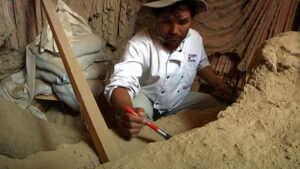
Archaeologist Qadir Temori at work. Credit Brent Huffman, Saving Mes Aynak.
In August 2018, Cultural Property News published a major article on the excavations at the Buddhist site of Mes Aynak and the remarkable dedication and perseverance of Afghan archaeologists in incredibly harsh conditions – all of which was brilliantly portrayed in the award-winning documentary Saving Mes Aynak by filmmaker Brent Huffman. Mes Aynak: Corruption, Copper and a Nation’s Heritage was about China’s attempt to dominate the world copper market by digging a giant pit-mine, utterly destroying an extraordinarily rich ancient Buddhist monastery complex outside of Kabul, Afghanistan.
Now, Brent Huffman returns to update the story: the discovery of major works of art scattered throughout a valley filled with buried monuments, attacks by insurgents that frightened off the Chinese miners but not the Afghan archaeologists, the tragic death of archaeologist Abdul Wahab Ferozi by the Taliban, the toxic threat to the local environment and the misery of hundreds of villagers driven from their homes.
CPN thanks Brent Huffman and Tricyle for permission to reprint “How a Historic Buddhist Site Has Eluded Destruction—for Now“, which appeared in Tricycle: The Buddhist Review, Feburary, 2020. http://tricycle.org. Huffman is a well-known documentary filmmaker and associate professor at Northwestern University. His film about Mes Aynak, a complete visual record of the archaeologists’ work and findings, was released in 2015. He recently produced Finding Yingying, a documentary about a Chinese visiting scholar kidnapped in Illinois in 2017, and is directing Strands of Resistance, a documentary examining China’s economic presence in Pakistan.
Brent Huffman: How a Historic Buddhist Site Has Eluded Destruction—for Now
“Back in 2009, few seemed to know about or care about Mes Aynak, an ancient Buddhist city in Afghanistan. There was no mention of it in a New York Times story about a shocking and surreal investment in Afghanistan from China. A Chinese government-owned mining company, one of the largest in the world, was setting up an encampment in Logar province in an area controlled by the Taliban. The China Metallurgical Group Corporation (MCC) had inked a deal with the Afghan government to mine $100 billion worth of copper buried at the site, which the MCC was able to lease for 30 years for a little less than $3 billion.
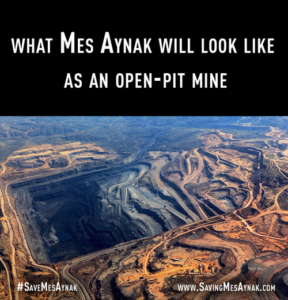
What Mes Aynak will look like as an open-pit mine. Credit www.Saving Mes Aynak.
The Times story was full of record-breaking details: the copper deposit at Mes Aynak was one of the largest untapped copper reserves in the world, and the MCC deal was the largest foreign investment in Afghanistan’s history. Not mentioned were the ancient ruins of a large Buddhist city a French geologist had stumbled across at the site in 1963, forgotten for centuries. The MCC planned to extract the copper at Mes Aynak via open-pit mining, the cheapest, fastest, and most environmentally destructive excavation technique, which would have demolished the ruins, leaving a gaping crater in their place. In 2009, the MCC and the Afghan government were banking on the world not knowing what was at stake at Mes Aynak.
I am a documentary filmmaker and professor at Northwestern University’s Medill School of Journalism and I had worked in Afghanistan before. I decided to return to Kabul in 2011 to see if I could gain access to Mes Aynak and see for myself what was there. What I found was astounding and would change my life. I traveled to Mes Aynak alone in a rented taxi though rocky dusty roads rife with landmines. Mes Aynak was awe-inspiring. It was a sprawling Buddhist city over 450,000 square meters in size, around the size of 100 football fields, dating back 2,000 years. Only 10 percent of the site had been excavated. It reminded me of Machu Picchu and I immediately fell in love.
The ancient city of Mes Aynak contains over 600 Buddha statues, dozens of intricate and fragile Buddhist stupas, an enormous circular monastic complex, thousands of coins and pieces of jewelry, as well as numerous ancient manuscripts and human remains. According to archaeologists, Mes Aynak represents one of the most significant archaeological finds in Afghanistan’s history and one of immense global importance due to its rare, well-preserved Buddhist artifacts, and to its sheer size. Over two thousand years ago, the residents of Mes Aynak were already mining copper using primitive drilling methods and smelters, explaining their close proximity to the precious metal. Mes Aynak was also a major stop on the Silk Road. Buddhists from all over Asia made pilgrimages to worship there and to trade with the city’s residents. This often overlooked chapter of Afghanistan’s history rests within Mes Aynak’s sprawling ruins.
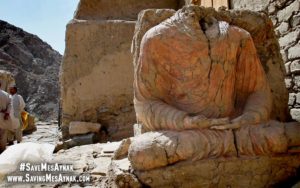
Saving Mes Aynak, photo Brent Huffman “Saving Mes Aynak”
So far, archaeologists have found incredible objects from the Kushan period (around 30–375 CE), including rare hand-carved wooden Buddha figures in the Gandhara style, painted plaster and clay statues in a variety of styles, and fragile birch bark manuscripts in several languages. Archaeologists also have unearthed Bronze Age pottery and a copper smelter dating back 4,000–6,000 years. A stone stele discovered at Mes Aynak has been identified as a depiction of Prince Siddhartha before he founded Buddhism, and has been taken as evidence that a monastic religion dedicated to Siddhartha’s pre-enlightenment life once existed in the region. Mes Aynak’s priceless treasures also include some of the oldest manuscripts and oil-paint murals ever discovered.
Everything was set to be destroyed by this copper mine—the proposed dynamiting echoing the Taliban’s 2001 destruction of the giant Buddhas at Bamiyan. Then there is the environmental devastation from open-pit copper mining. As a result of copper extraction, Mes Aynak would become a toxic crater. Chemical byproducts would soak into aquifers that supply drinking water to Kabul (population of approximately 6 million) and neighboring Pakistan. To make way for mining, a dozen nearby villages were cleared without the consent of the villagers, whose families had lived there for generations. And with the MCC planning to bring in its own employees from China, Afghan citizens would see little benefit from this corrupt deal, the contract for which was never made public due to a lack of transparency in the Afghan government.

MJAM camp Mes Aynak, Afghan Ministry of Mines photo.
I was shocked and horrified. I rushed to get the word out, to spread awareness in an attempt to stop the mining. I wrote articles and did interviews for the New York Times, CNN, BBC, NPR, Al Jazeera, Huffington Post, and Tricycle; I spread the word on social media; and I partnered with an Afghan graduate student who began a petition to save Mes Aynak.
I quickly learned the true heroes of this story were the Afghan archaeologists risking their lives to excavate the site amid daily threats from the Taliban. The MCC gave these archaeologists one year to perform rescue archaeology at the sprawling ancient city; after an international outcry, they extended the deadline to three years. A proper excavation would take more than 30 years. The archaeologists often went months without pay and were not given cameras or computers to document their findings. (I later raised money in a Kickstarter campaign to buy cameras and computers for them.)
Meanwhile, I continued to make a film documenting everything that happened. The resulting documentary, Saving Mes Aynak, was in many ways a love letter to these Afghan archaeologists, to Mes Aynak, and to Afghanistan. I hoped to show the world how special and incredible this country is, both in its people and cultural heritage.
For the first three years I worked on Saving Mes Aynak solo, but others soon came to help save Mes Aynak. Legendary Chicago social justice documentary house Kartemquin Films joined me to help produce the film. The MacArthur Foundation awarded me a documentary grant and other foundations followed suit. The completed documentary went on to win over 30 major awards and has been broadcast on television in more than 70 countries, and was translated into Dari and broadcast for free in Afghanistan in 2015.
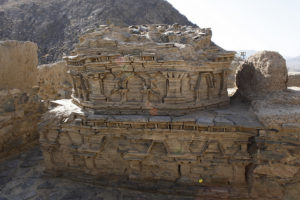
Mes Aynak, Stupa, US Embassy photo.
It sounds cliché to say documentaries can make a difference, but it is true in the case of Saving Mes Aynak. Five years after the film’s debut, Mes Aynak is still intact—but it still could be destroyed at any time.
Saving Mes Aynak played a significant role in causing the MCC and the Afghan government to delay demolition of the site that continues to this day. Nearly 90,000 people signed the petition to save the ancient city, and Afghan presidents Hamid Karzai (2001–2014) and Ashraf Ghani (2014–present) viewed the film and pledged support. In 2017, the general manager of the MCC, Shen Heting, was expelled from the Communist Party on corruption charges; it’s possible that Saving Mes Aynak had even reached the Chinese government and influenced their decision.
In the early 2010s, archaeologists uncovered an important Buddhist manuscript written in Sanskrit on tree bark, dated to the 7th century, which suggests the site was a prosperous Buddhist city. According to this recently translated manuscript, Mes Aynak may have been the city described by 7th-century Chinese monk Hsuan-tsang (Xuanzang) in the Great Tang Records on the Western Regions, which recorded his journey to India. UNESCO is now officially advising on archaeological excavation and preservation at Mes Aynak, and plans are afoot for a new museum near the ruins to house and display findings.
Archaeologist Qadir Temori, lead Afghan archaeologist at Mes Aynak, was promoted to Director of the Archaeology Department at the Ministry of Culture and now oversees the protection of all endangered sites in Afghanistan. He works closely with the Oriental Institute at the University of Chicago to map ancient sites via satellite to safeguard them from looting.
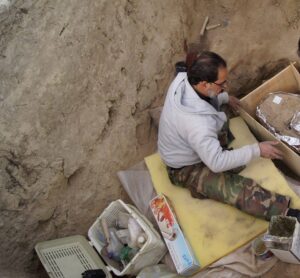
Archaeologist Abdul Wahab Ferozi, killed in a bomb blast in 2018. Credit www.Saving Mes Aynak.com
But not all the news has been good. Tragically, in 2018 Afghan archaeologist Abdul Wahab Ferozi was killed by the Taliban in a bomb blast while traveling to work at Mes Aynak. Three others were also wounded in the explosion. This incident showed the peril archaeologists still face daily.
The Chinese government is working directly with the Taliban and has hosted them in Beijing as recently as 2019 to cease attacks on the MCC in Logar province and partner in the extraction industry in Afghanistan. The Afghan Ministry of Mines has been pressing the MCC to begin mining as soon as possible, despite the fact that mining would destroy the ancient city and pollute the area.
Mes Aynak, and everything still buried in the ground, could be destroyed at any time. A primary goal of Saving Mes Aynak was to make Mes Aynak a UNESCO World Heritage Site and permanently stop any mining from ever happening at the site. Though this has not yet happened, it is not too late.
No one should be allowed to erase a country’s cultural heritage and identity and permanently poison its people and environment. Mes Aynak’s cultural treasures must be preserved for future generations. But that has yet to happen. There is more work to do.”
CPN notes:
Without Huffman’s activism and his work to bring global attention to the peril of one of the world’s most important ancient sites, the concerns of Afghanistan’s archaeologists and international scholars about preserving a great monument of world heritage would probably have been swept aside years ago. The reason? The mineral riches of Afghanistan, including copper, lithium, talc, marble, gold, uranium and rare earths such as neodymium and dysprosium, are estimated at about $1Trillion in value. The potential wealth this represents has resulted in repeated power struggles both within its government and with outside power players from the Chinese to the Taliban. The government’s inability to monitor or control mining across Afghanistan and to enforce duties on exported minerals has deprived the country of the financial resources it desperately needs for development and to provide health, education and other social services to its citizens. Government officials and Members of Afghanistan’s Parliament are known to have vested economic interests in mining throughout the country, warlords and petty chiefs have established thousands of illegal or quasi-legal mines, often in remote locales, and the Taliban is estimated to earn between $2.5m and $10m a year from mining talc alone, its second source of income after opium.
Halting the destruction of mineral-rich sites by unauthorized extractors will only be possible when there is security for legitimate businesses and when the Afghan government demands that miners operate with transparency and oversight. Because mining sites are often found in proximity to ancient remains there must also be recognition of the non-pecuniary value of Afghanistan’s ancient heritage by its citizens, and a commitment to preservation, such has been shown by heroic archaeologists like Qadir Temori, whose work has been documented in Saving Mes Aynak.
More stories and pictures:
Afghanistan 1975 – Before War – Photographs by Françoise Foliot, Cultural Property News, April 10, 2020
Mes Aynak: Corruption, Copper and a Nation’s Heritage , Cultural Property News, August 23, 2018
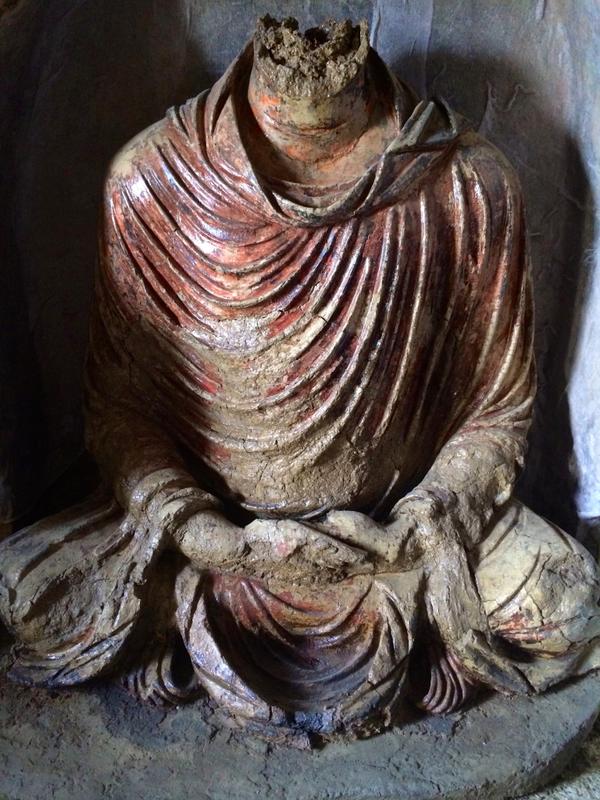 Mes Aynak. Figure of seated Buddha with head removed or destroyed. Credit Brent Huffman, www.Saving Mes Aynak.com
Mes Aynak. Figure of seated Buddha with head removed or destroyed. Credit Brent Huffman, www.Saving Mes Aynak.com 

